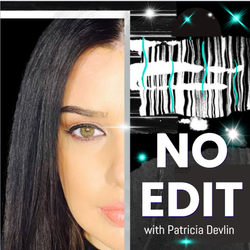Share

No Edit with Patricia Devlin
Murder of a Journalist
Martin O'Hagan had been at the height of his journalism career when he was brutally executed in the street by members of a loyalist paramilitary gang in September 2001. His last act of bravery was to sheild his wife from the bullets that took his life.
The Sunday World reporter's brave exposes, hard hitting articles and insightful investigations into the dark underbelly of Northern Ireland's paramafia gangs sadly sealed his death warrant.
But could his murder, carried out by the Loyalist Volunteer Force (LVF), been prevented? And what's stopping police from bringing charges against those involved?
In this epsiode, Martin's brother Fintan O'Hagan talks about the fight for justice for Martin whose killers have been allowed to roam free despite those willing to give evidence against them. And he talks openly about why he believes the courageous journalist has not only been let down by the authorities, but also by his own industry.
More episodes
View all episodes

Crucified
01:15:44|Belfast, May 1996.A 17 year-old boy is bundled into a car by four masked men.A sock is shoved inside his mouth to dull his screams. He is beaten before being driven at speed to an alleyway in the nearby republican heartland of Ballymurphy. He is removed from the car; his arms and legs are bound with tape and rope. His attackers hang him upside down on a wooden fence. It was like being crucified.What happens next is what's known as a 'punishment' beating. Attacks regularly carried out in Northern Ireland by paramilitaries, supposedly, to keep their communities in order.That teenager survived, though he was unable to walk for many months. Today, he is a father in his mid 40s who almost three decades after the attack, has received vindication. Paul Reid was handed an apology from the IRA for the brutal and cold attack he received as a teenager.Born into a staunch republican family, Paul's father Patsy was a renowned IRA man who was jailed for the attempted murder of two judges. His uncle, Billy Reid, is described in the press as 'republican royalty' after becoming the first IRA man to have shot dead a British soldier.His story is as far away from violence as it gets, it's about forgiveness. not only forgiving those who harmed him, but forgiving himself and asking forgiveness from God.
The collusive murder of Raymond McCord Jnr
01:06:57|What is ‘collusion?” The dictionary quotes it as: a secret or illegal cooperation or conspiracy in order to deceive others.”In Northern Ireland, far too many know its devastating reality. On November 9, 1997, 22 year-old Raymond McCord Jnr was lured to the grounds of a disused quarry on the outskirts of Belfast. There, members of the Ulster Volunteer Force (UVF) brutally beat him to death. His injuries were so severe, he could be only identified through his fingerprints.His murder sparked one of the most damning public inquiries into the workings of the UVF, and the paramilitary gang’s close workings with the RUC.Operation Ballast, headed by then police ombudsman Nuala O’Loan, revealed how paramilitary killers were protected from prosecution because they were police agents.The 2007 report also exposed UVF commander Mark Haddock as a high ranking police informant who carried out several murders, beatings and gun attacks whilst being on the pay roll of the security forces. It was estimated he’d been paid more £80,000 for information whilst his unit conducted a reign of terror in north Belfast and mid ulster. It was on Haddock’s orders that Raymond McCord Jnr was murdered.Today, his father speaks to No Edit about the son he lost and his family’s battle to finally get justice for his killing.Campaigner Raymond McCord Snr also reveals his own battles with paramilitaries and how a UVF threat on his life remains active to this very day.
Broken Dreams
30:18|In the mid 1990s, Donal Gray was a rising star on the football scene.Gaining caps for the Northern Ireland youth squad, he played in the Irish League before his talent saw him signed in Scotland where he had the chance to play against his heroes.But his dream of playing professional football was cruelly taken away when, in 1996, the then 19 year-old was subjected to a brutal paramilitary assault in the front garden of his Co Down home.Up to 10 masked men attacked the teenager with cudgels, pickaxes and iron bars. His legs were so severely broken, doctors said he would never play football again.The so-called punishment beating was carried out by members of the Provisional IRA. The press reported at the time how the rising football star was the 400th victim of the republican paramilitary group's brutal assaults.In this episode, Donal talks about the attack, and the long, hard road to both physical and mental recovery.
The US Marine turned IRA Gunrunner
01:23:43|Born in New York to Irish parents, John Crawley knew from a young age exactly what he wanted to do with his life - join the IRA.Enlisting in an elite unit of the US Marine Corps, his only goal was to receive the most intensive military training possible so he could go 'home' to Ireland and fight to end the British occupation of the North.He did, and received a total of 45 years in prison for both gunrunning and bomb plots.His recently released memoir 'The Yank' recounts his extraordinary experiences during gruelling Marine Corps training, and how, not long after his discharge, he joined the IRA. His life in the Provisonal IRA led him back to America where he would work with notorious American mobster James ‘Whitey’ Bulger to amass a shipment of weapons only to be captured a gunrunning trawler off the Kerry coast.Upon his release, he became one of the masterminds behind the IRA’s plan to throw London’s electrical system into disarray.In this interview, Crawley is candid about the people he worked with and unflinching in his commentary on the IRA leadership.
Teenager in the IRA
01:15:53|Thomas 'Dixie' Elliott was just 16 years old when he was recruited into the ranks of the Provisional IRA.By the age of 19, he was in jail.Sentenced to 12 years in prison for the the attempted murder of a British soldier, he had fully committed himself to violent republicanism.He claims he saw no other alternative.Born to a Catholic mother and a Presbyterian father, he grew up in Derry city during the worst years of civil unrest.. His want to join the IRA was fuelled by the Royal Ulster Constabulary and British army's treatment of the nationalist community.Now 65 years old, the former blanketman - who shared prison cells with hungerstrikers Bobby Sands and Thomas McElwee - refuses to romanticise the IRA's campaign of violence. In fact, he now belives it was 'for nothing'.
The Glengannon Hotel Shooting
58:10|On December 27, 1997, loyalist gunmen unleashed a hail of bullets at the entrance of a packed out disco in Northern Ireland.The ruthless attack at the Glengannon Hotel in Co Tyrone left one man dead and three others seriously injured.The shooting was in revenge for the INLA prison murder of Loyalist Volunteer Force (LVF) leader Billy Wright just hours earlier.Ruairi Cummings was just 17 when he witnessed the horrors of that night. His father Christy was gunned down in front of his very eyes. His injuries left him paralyzed for life.Almost 25 years later, the Cummings family are still fighting for justice, and the truth, over the night that changed their lives forever.
From Murder to God
01:06:14|Loyalist Alec 'Ozzo' Calderwood was just 17 years-old when he brutally beat Catholic Alexander Reid to death with a breeze block in 1980.The father of one was targeted solely because of his religion.In this episode, the man who carried out that killing talks about his involement in the purely sectarian murder, being sentenced to life imprisonment and finding God behind bars.He speaks frankly about The Troubles, religious hatred, love, God, his regrets, and most importantly, how he wants to see communities in Northern Ireland never return to the past.
Norah
45:54|On July 8, 1981, a mother of three left her Northern Ireland home to get milk. She never made it home.Norah McCabe, 33, was gunned down as she walked down the street by a plastic bullet fired from the barrel of a police man's gun. The Royal Ulster Constabulary (RUC) would later claim they were defending officers who were about to be attacked with a petrol bomb as riots and disorder broke out on the streets of Belfast. It was all a lie. Over 40 years later, her family still do not know why Norah, whose youngest child was just three months old when she was killed, was targeted with the deadly weapon round.Her son James speaks exclusively to No Edit about the mum he never got to love, his family's fight for truth and the ongoing campaign to end the use of plastic bullets that are still being used by police forces around the world today.